Impact of Climate Change and Technological Innovation on the Energy Performance and Built form of Future Cities
Abstract
1. Introduction
2. Research Methodology
2.1. Formulating the Future Scenario
2.1.1. Global Warming and Climate Change
2.1.2. Transportation Model and Future Technologies
2.2. Energy Simulation
3. Results
3.1. Correlation of Building/Transportation Energy Demands with Urban Built Form and Density
3.2. Correlation of PV Generation, Building/Transportation Energy Loads, Urban Built Form, and Density
3.3. PV Generation vs. EV Consumption
3.4. Heating to Cooling Ratio and Its Implications
3.5. Impact of the Cut-Off Angle on Building/Transportation Energy Loads
3.6. Comparison of the Energy Performance of the Different Built Forms
3.7. Comparison of the Building Energy Deman of 2050 with Present Time
4. Discussion
5. Conclusions
- The results show that by 2050 buildings with greater plan depth and lower number of storeys (being equivalent to high site coverage and low plot ratio) will acquire higher values of Energy Equity that increase the possibility of building energy self-sufficiency. Although this trend is similar to the present scenario, the magnitude of Energy Equity is considerably lower in the future because of (i) additional cooling loads, and (ii) added EV charging to the building load.
- Unlike the present-day climate of London, increasing the cut-off angle mainly leads to a reduction in energy demand (with no effect on buildings with great plan depth), which shows the impact of having a cooling load as part of the building energy demand. It is also concluded that the building cooling load is more sensitive against the external environment changes such as varying the cut-off angle compared with heating loads.
- Having a similar geometry, the tunnel-court form indicates the highest Energy Equity and the lowest energy demand, while the pavilion form shows the poorest performance. Generally, court and tunnel-court forms show better energy performance in future climate scenarios compared with their performance in the present climate. Hence, it can be advised that for future urban developments in London, these two built forms are more advantageous in terms of energy to accommodate the changing climate.
- Finally, results of simulation trials indicate that the total building energy demand in 2050 is 40% higher, on average, than in the present climate, as a result of additional cooling load and EV charging consumption. This increase is much higher for buildings with a low heating to cooling ratio, which is the product of a specific combination of built form, density and geometrical parameters. For instance, this happens for buildings with small plan depth, a low cut-off angle and a high number of storeys, where their effect is magnified in pavilion and terrace forms. Hence, results from this study recommend that these configurations should be avoided for future urban developments in London to avoid excessive building cooling demand that has a higher contribution in environmental pollution compared with heating demand.
6. Limitations
Author Contributions
Funding
Conflicts of Interest
Appendix A

References
- Elnokaly, A.; Ayoub, M.; Elseragy, A. Parametric investigation of traditional vaulted roofs in hot-arid climates. Renew. Energy 2019, 138, 250–262. [Google Scholar] [CrossRef]
- Li, Y.; Wang, W.; Wang, Y.; Xin, Y.; He, T.; Zhao, G. A review of studies involving the effects of climate change on the energy consumption for building heating and cooling. Int. J. Environ. Res. Public Health 2021, 18, 40. [Google Scholar] [CrossRef] [PubMed]
- UN ESCAP. Accelerating SDG7 Achievement in the Time of COVID-19: Policy Briefs in Support of the High-Level Political Forum 2020; 2020; Available online: https://www.google.com/url?sa=t&rct=j&q=&esrc=s&source=web&cd=&cad=rja&uact=8&ved=2ahUKEwi8sZyl6bH7AhWR9jgGHcHBCVEQFnoECAgQAQ&url=https%3A%2F%2Fsustainabledevelopment.un.org%2Fcontent%2Fdocuments%2F26235UNFINALFINAL.pdf&usg=AOvVaw34s-tBP7qwXppDHeH_HBQX (accessed on 25 January 2021).
- Pyrgou, A.; Castaldo, V.L.; Pisello, A.L.; Cotana, F.; Santamouris, M. On the effect of summer heatwaves and urban overheating on building thermal-energy performance in central Italy. Sustain. Cities Soc. 2017, 28, 187–200. [Google Scholar] [CrossRef]
- Schaeffer, R.; Szklo, A.S.; de Lucena, A.F.P.; Borba, B.S.M.C.; Nogueira, L.P.P.; Fleming, F.P.; Troccoli, A.; Harrison, M.; Boulahya, M.S. Energy sector vulnerability to climate change: A review. Energy 2012, 38, 1–12. [Google Scholar] [CrossRef]
- Berger, M.; Worlitschek, J. The link between climate and thermal energy demand on national level: A case study on Switzerland. Energy Build. 2019, 202, 109372. [Google Scholar] [CrossRef]
- Masson, V.; Marchadier, C.; Adolphe, L.; Aguejdad, R.; Avner, P.; Bonhomme, M.; Bretagne, G.; Briottet, X.; Bueno, B.; De Munck, C. Adapting cities to climate change: A systemic modelling approach. Urban Clim. 2014, 10, 407–429. [Google Scholar] [CrossRef]
- Yang, Y.; Javanroodi, K.; Nik, V.M. Climate change and energy performance of European residential building stocks—A comprehensive impact assessment using climate big data from the coordinated regional climate downscaling experiment. Appl. Energy 2021, 298, 117246. [Google Scholar] [CrossRef]
- Tsirigoti, D.; Tsikaloudaki, K. The effect of climate conditions on the relation between energy efficiency and urban form. Energies 2018, 11, 582. [Google Scholar] [CrossRef]
- Mangan, S.D.; Oral, G.K. Impacts of future weather data on the energy performance of buildings in the context of urban geometry. Cogent Eng. 2020, 7, 1714112. [Google Scholar] [CrossRef]
- Bamdad, K.; Matour, S.; Izadyar, N.; Omrani, S. Impact of climate change on energy saving potentials of natural ventilation and ceiling fans in mixed-mode buildings. Build. Environ. 2022, 209, 108662. [Google Scholar] [CrossRef]
- Campagna, L.M.; Fiorito, F. On the Impact of Climate Change on Building Energy Consumptions: A Meta-Analysis. Energies 2022, 15, 354. [Google Scholar] [CrossRef]
- Hosseini, M.; Javanroodi, K.; Nik, V.M. High-resolution impact assessment of climate change on building energy performance considering extreme weather events and microclimate–Investigating variations in indoor thermal comfort and degree-days. Sustain. Cities Soc. 2022, 78, 103634. [Google Scholar] [CrossRef]
- Ewing, R.; Rong, F. The impact of urban form on US residential energy use. Hous. Policy Debate 2008, 19, 1–30. [Google Scholar] [CrossRef]
- Große, J.; Fertner, C.; Groth, N.B. Urban structure, energy and planning: Findings from three cities in Sweden, Finland and Estonia. Urban Plan. 2016, 1, 24–40. [Google Scholar] [CrossRef]
- Guhathakurta, S.; Williams, E. Impact of urban form on energy use in central city and suburban neighborhoods: Lessons from the phoenix metropolitan region. Energy Procedia 2015, 75, 2928–2933. [Google Scholar] [CrossRef][Green Version]
- Byrd, H. The Power of Subarbia. In Infinite Suburbia; Berger, A., Kotkin, J., Guzman, C.B., Eds.; Princeton Architectural Press: New York, NY, USA, 2017; pp. 608–623. [Google Scholar]
- Appavou, F.; Brown, A.; Epp, B.; Leidreiter, A.; Lins, C.; Murdock, H.; Musolino, E.; Petrichenko, K.; Farrell, T.; Krader, T. Renewables 2017 global status report. In Renewable Energy Policy Network for the 21st Century; REN21: Paris, France, 2017. [Google Scholar]
- Jones, S.R.; Gillott, M.; Boukhanouf, R.; Walker, G.; Tunzi, M.; Tetlow, D.; Rodrigues, L.; Sumner, M. A system design for distributed energy generation in low-temperature district heating (LTDH) networks. Future Cities Environ. 2019, 5, 2. [Google Scholar] [CrossRef]
- Waibel, C.; Evins, R.; Carmeliet, J. Co-simulation and optimization of building geometry and multi-energy systems: Interdependencies in energy supply, energy demand and solar potentials. Appl. Energy 2019, 242, 1661–1682. [Google Scholar] [CrossRef]
- Delmastro, C.; Mutani, G.; Schranz, L.; Vicentini, G. The role of urban form and socio-economic variables for estimating the building energy savings potential at the urban scale. Int. J. Heat Technol. 2015, 33, 91–100. [Google Scholar] [CrossRef]
- Rickwood, P.; Glazebrook, G.; Searle, G. Urban structure and energy—A review. Urban Policy Res. 2008, 26, 57–81. [Google Scholar] [CrossRef]
- Silva, M.; Oliveira, V.; Leal, V. Urban Form and Energy Demand: A Review of Energy-relevant Urban Attributes. J. Plan. Lit. 2017, 32, 346–365. [Google Scholar] [CrossRef]
- Bhiwapurkar, P. Determinants of Urban Energy Use: Density and Urban Form. In Proceedings of the ARCC Conference Repository, Charlotte, NC, USA, 27–30 March 2013. [Google Scholar]
- Resch, E.; Bohne, R.A.; Kvamsdal, T.; Lohne, J. Impact of urban density and building height on energy use in cities. Energy Procedia 2016, 96, 800–814. [Google Scholar] [CrossRef]
- Steemers, K. Energy and the city: Density, buildings and transport. Energy Build. 2003, 35, 3–14. [Google Scholar] [CrossRef]
- Güneralp, B.; Zhou, Y.; Ürge-Vorsatz, D.; Gupta, M.; Yu, S.; Patel, P.L.; Fragkias, M.; Li, X.; Seto, K.C. Global scenarios of urban density and its impacts on building energy use through 2050. Proc. Natl. Acad. Sci. USA 2017, 114, 8945–8950. [Google Scholar] [CrossRef] [PubMed]
- Steadman, P.; Hamilton, I.; Evans, S. Energy and urban built form: An empirical and statistical approach. Build. Res. Inf. 2014, 42, 17–31. [Google Scholar] [CrossRef]
- Boukarta, S.; Berezowska, E. Exploring the Energy Implication of Urban Density in Residential Buildings. J. Appl. Eng. Sci. 2017, 7, 7–14. [Google Scholar] [CrossRef]
- Hachem, C.; Athienitis, A.; Fazio, P. Investigation of solar potential of housing units in different neighborhood designs. Energy Build. 2011, 43, 2262–2273. [Google Scholar] [CrossRef]
- Mohajeri, N.; Upadhyay, G.; Gudmundsson, A.; Assouline, D.; Kämpf, J.; Scartezzini, J.-L. Effects of urban compactness on solar energy potential. Renew. Energy 2016, 93, 469–482. [Google Scholar] [CrossRef]
- Hargreaves, A.; Cheng, V.; Deshmukh, S.; Leach, M.; Steemers, K. Forecasting how residential urban form affects the regional carbon savings and costs of retrofitting and decentralized energy supply. Appl. Energy 2017, 186, 549–561. [Google Scholar] [CrossRef]
- Byrd, H.; Ho, A.; Sharp, B.; Kumar-Nair, N. Measuring the solar potential of a city and its implications for energy policy. Energy Policy 2013, 61, 944–952. [Google Scholar] [CrossRef]
- Echenique, M.H.; Hargreaves, A.J.; Mitchell, G.; Namdeo, A. Growing cities sustainably: Does urban form really matter? J. Am. Plan. Assoc. 2012, 78, 121–137. [Google Scholar] [CrossRef]
- Rafiee, A.; Dias, E.; Koomen, E. Analysing the impact of spatial context on the heat consumption of individual households. Renew. Sustain. Energy Rev. 2019, 112, 461–470. [Google Scholar] [CrossRef]
- Leng, H.; Ma, Y.; Wong, N.H.; Ming, T. Urban morphology and building heating energy consumption: Evidence from Harbin, a severe cold region city. Energy Build. 2020, 224, 110143. [Google Scholar] [CrossRef]
- Perera, A.; Coccolo, S.; Scartezzini, J.-L.; Mauree, D. Quantifying the impact of urban climate by extending the boundaries of urban energy system modeling. Appl. Energy 2018, 222, 847–860. [Google Scholar] [CrossRef]
- March, L. Elementary models of built forms. In Urban Space and Structures; Martin, L., March, L., Eds.; Cambridge University Press: Cambridge, UK, 1972; pp. 55–96. [Google Scholar]
- Ratti, C.; Raydan, D.; Steemers, K. Building form and environmental performance: Archetypes, analysis and an arid climate. Energy Build. 2003, 35, 49–59. [Google Scholar] [CrossRef]
- Emmanuel, R.; Steemers, K. Connecting the realms of urban form, density and microclimate. Build. Res. Inf. 2018, 48, 804–808. [Google Scholar] [CrossRef]
- Lee, G.; Jeong, Y. Impact of Urban and Building Form and Microclimate on the Energy Consumption of Buildings-Based on Statistical Analysis. J. Asian Archit. Build. Eng. 2017, 16, 565–572. [Google Scholar] [CrossRef]
- Morganti, M.; Coch Roura, H.; Cecere, C. The effects of urban obstructions in Mediterranean climates: Built form typology, density and energy. ACE Archit. City Environ. 2012, 7, 13–26. [Google Scholar] [CrossRef]
- Ahmadian, E.; Sodagar, B.; Mills, G.; Byrd, H.; Bingham, C.; Zolotas, A. Sustainable cities: The relationships between urban built forms and density indicators. Cities 2019, 95, 102382. [Google Scholar] [CrossRef]
- Ahmadian, E.; Sodagar, B.; Bingham, C.; Elnokaly, A.; Mills, G. Effect of urban built form and density on building energy performance in temperate climates. Energy Build. 2021, 236, 110762. [Google Scholar] [CrossRef]
- Hukkalainen, M.; Virtanen, M.; Paiho, S.; Airaksinen, M. Energy planning of low carbon urban areas-Examples from Finland. Sustain. Cities Soc. 2017, 35, 715–728. [Google Scholar] [CrossRef]
- Kaemco. CitySim Pro. Available online: www.kaemco.ch/download.php (accessed on 19 December 2018).
- Bazazzadeh, H.; Pilechiha, P.; Nadolny, A.; Mahdavinejad, M. The Impact Assessment of Climate Change on Building Energy Consumption in Poland. Energies 2021, 14, 4084. [Google Scholar] [CrossRef]
- Dorer, V.; Allegrini, J.; Orehounig, K.; Moonen, P.; Upadhyay, G.; Kämpf, J.; Carmeliet, J. Modelling the urban microclimate and its impact on the energy demand of buildings and building clusters. Proc. BS 2013, 2013, 3483–3489. [Google Scholar]
- Walter, E.; Kämpf, J.H. A verification of CitySim results using the BESTEST and monitored consumption values. In Proceedings of the 2nd Building Simulation Applications Conference, Bozen-Bolzano, Italy, 4–6 February 2015; pp. 215–222. [Google Scholar]
- Coccolo, S.; Kämpf, J.H.; Scartezzini, J.-L. Design in the desert. A Bioclimatic project with urban energy modelling. In Proceedings of the 13th Conference of International Building Performance Simulation Association, Chambéry, France, 26–28 August 2013. [Google Scholar]
- Meteonorm. Meteonorm Software. Available online: https://meteonorm.com/en/ (accessed on 1 February 2021).
- Masson-Delmotte, V.; Zhai, P.; Pörtner, H.-O.; Roberts, D.; Skea, J.; Shukla, P.R.; Pirani, A.; Moufouma-Okia, W.; Péan, C.; Pidcock, R. Global Warming of 1.5 °C; An IPCC Special Report on the Impacts of Global Warming of 1.5 °C; IPCC: Cambridge, UK; New York, NY, USA, 2018.
- UK Government. UK Becomes First Major Economy to Pass Net Zero Emissions Law. Department for Business, Energy & Industrial Strategy. Available online: https://www.gov.uk/government/news/uk-becomes-first-major-economy-to-pass-net-zero-emissions-law (accessed on 25 January 2021).
- World Wide Fund for Nature UK. Reducing Carbon Emissions in the UK. Available online: https://www.wwf.org.uk/what-we-do/projects/reducing-carbon-emissions-uk?pc=AUT005007&gclsrc=aw.ds&&gclid=CjwKCAiAxp-ABhALEiwAXm6IycfdtCYdytBvNxYcgUW8tkgQ0sKoTv19urUcCc6R4tyuDPDHO77QCRoCwhQQAvD_BwE&gclsrc=aw.ds (accessed on 25 January 2021).
- Nakicenovic, N.; Swart, R. Emissions Scenarios. Special Report of the Intergovernmental Panel on Climate Change; Cambridge University Press: Cambridge, UK, 2000. [Google Scholar]
- IPCC. IPCC Fifth Assessment Synthesis Report; Intergovernmental Panel on Climate Change: Geneva, Switzerland, 2014.
- Xu, P.; Huang, Y.J.; Miller, N.; Schlegel, N.; Shen, P. Impacts of climate change on building heating and cooling energy patterns in California. Energy 2012, 44, 792–804. [Google Scholar] [CrossRef]
- Gabbatiss, J. Transport Becomes Most Polluting UK Sector as Greenhouse Gas Emissions Drop Overall. Independent. Available online: https://www.independent.co.uk/climate-change/news/air-pollution-uk-transport-most-polluting-sector-greenhouse-gas-emissions-drop-carbon-dioxide-climate-change-a8196866.html (accessed on 16 February 2021).
- Energy Saving Trust. On the Path to Net Zero: Transport. Available online: https://energysavingtrust.org.uk/path-net-zero-transport/ (accessed on 25 January 2021).
- Ahmadian, E.; Byrd, H.; Sodagar, B.; Matthewman, S.; Kenney, C.; Mills, G. Energy and the form of cities: The counterintuitive impact of disruptive technologies. Archit. Sci. Rev. 2019, 62, 145–151. [Google Scholar] [CrossRef]
- Nikonowicz, L.B.; Milewski, J. Virtual Power Plants-general review: Structure, application and optimization. J. Power Technol. 2012, 92, 135. [Google Scholar]
- Edwardes-Evans, H. UK Smart Export Guarantee to Reward Prosumers from 2020; S & P Global: London, UK; Available online: https://www.spglobal.com/commodity-insights/en/market-insights/latest-news/electric-power/061119-uk-smart-export-guarantee-to-reward-prosumers-from-2020 (accessed on 18 May 2022).
- Mengelkamp, E.; Notheisen, B.; Beer, C.; Dauer, D.; Weinhardt, C. A blockchain-based smart grid: Towards sustainable local energy markets. Comput. Sci.-Res. Dev. 2018, 33, 207–214. [Google Scholar] [CrossRef]
- Pieroni, A.; Scarpato, N.; Di Nunzio, L.; Fallucchi, F.; Raso, M. Smarter City: Smart Energy Grid based on Blockchain Technology. Int. J. Adv. Sci. Eng. Inf. Technol. 2018, 8, 298–306. [Google Scholar] [CrossRef]
- Zero Carbon Futures. London Electric Vehicle Infrastructure Delivery Plan; Zero Carbon Futures: London, UK, 2019. [Google Scholar]
- Liao, W.; Xu, S.; Heo, Y. Evaluation of model fidelity for solar analysis in the context of distributed PV integration at urban scale. Build. Simul. 2021, 15, 3–16. [Google Scholar] [CrossRef]
- Feist, W.; Pfluger, R.; Kaufmann, B.; Schnieders, J.; Kah, O. Passive house planning package 2007. In Specifications for Quality Approved Passive Houses; echnical Information PHI-2007/1 (E); Passivhaus Institut: Darmstadt, Germany, 2007. [Google Scholar]
- Hopkin, C.; Spearpoint, M.; Hopkin, D.; Wang, Y. Residential occupant density distributions derived from English Housing Survey data. Fire Saf. J. 2019, 104, 147–158. [Google Scholar] [CrossRef]
- The Faraday Institution. The Road to Electrification—From the Internal Combustion Engine to the Battery Electric Vehicle; The Faraday Institution: Didcot, UK, 2019. [Google Scholar]
- Department for Transport. The Road to Zero: Next Steps towards Cleaner Road Transport and Delivering our Industrial Strategy; Department of Transport: London, UK, 2018.
- Barrett, S.; Wills, J.; Washington-Ihieme, M. Reclaim the Kerb: The Future of Parking and Kerbside Management. Center for London. Available online: https://www.centreforlondon.org/reader/parking-kerbside-mangement/chapter-1/#car-ownership-in-london-has-changed-little-over-time (accessed on 25 January 2021).
- Transport for London. Roads Task Force—Technical Note 12. In How Many Cars Are There in London and Who Owns Them? Available online: https://docplayer.net/150497-Roads-task-force-technical-note-12-how-many-cars-are-there-in-london-and-who-owns-them.html (accessed on 25 January 2021).
- Statistica. Number of Households in the United Kingdom (UK) in 2019, by Size (in 1000). Available online: https://www.statista.com/statistics/281627/households-in-the-united-kingdom-uk-by-size/ (accessed on 25 January 2021).
- Mayor of London. Context and Strategy. Available online: https://www.london.gov.uk/what-we-do/planning/london-plan/current-london-plan/london-plan-chapter-one-context-and-strategy-5#:~:text=However%2C%20the%20Census%20that%20year,projected%20scale%20of%20household%20growth (accessed on 25 January 2021).
- UK Government. Vehicle Mileage and Occupancy; Department for Transport: London, UK, 2020.
- Electric Vehicle Database. Energy Consumption of Electric Vehicles. Available online: https://ev-database.uk/cheatsheet/energy-consumption-electric-car (accessed on 25 January 2021).
- Rodrigues, L.T.; Gillott, M.; Tetlow, D. Summer overheating potential in a low-energy steel frame house in future climate scenarios. Sustain. Cities Soc. 2013, 7, 1–15. [Google Scholar] [CrossRef]
- Hanlon, H.M.; Bernie, D.; Carigi, G.; Lowe, J.A. Future changes to high impact weather in the UK. Clim. Change 2021, 166, 1–23. [Google Scholar] [CrossRef]
- Hayles, C.S.; Huddleston, M.; Chinowsky, P.; Helman, J. Summertime impacts of climate change on dwellings in Wales, UK. Build. Environ. 2022, 219, 109185. [Google Scholar] [CrossRef]
- Kolokotroni, M.; Ren, X.; Davies, M.; Mavrogianni, A. London’s urban heat island: Impact on current and future energy consumption in office buildings. Energy Build. 2012, 47, 302–311. [Google Scholar] [CrossRef]
- Javanroodi, K.; Mahdavinejad, M.; Nik, V.M. Impacts of urban morphology on reducing cooling load and increasing ventilation potential in hot-arid climate. Appl. Energy 2018, 231, 714–746. [Google Scholar] [CrossRef]
- Collins, L.; Natarajan, S.; Levermore, G. Climate change and future energy consumption in UK housing stock. Build. Serv. Eng. Res. Technol. 2010, 31, 75–90. [Google Scholar] [CrossRef]
- Gupta, R.; Gregg, M. Using UK climate change projections to adapt existing English homes for a warming climate. Build. Environ. 2012, 55, 20–42. [Google Scholar] [CrossRef]
- Amoako-Attah, J.; Bahadori-Jahromi, A. Impact of future climate change on UK building performance. Adv. Environ. Res. 2013, 2, 203–227. [Google Scholar] [CrossRef]
- Roselli, C.; Sasso, M. Integration between electric vehicle charging and PV system to increase self-consumption of an office application. Energy Convers. Manag. 2016, 130, 130–140. [Google Scholar] [CrossRef]
- Bansal, P.; Vineyard, E.; Abdelaziz, O. Advances in household appliances—A review. Appl. Therm. Eng. 2011, 31, 3748–3760. [Google Scholar] [CrossRef]
- Borg, S.P.; Kelly, N. The effect of appliance energy efficiency improvements on domestic electric loads in European households. Energy Build. 2011, 43, 2240–2250. [Google Scholar] [CrossRef]
- Nikoofard, S.; Ugursal, V.I.; Beausoleil-Morrison, I. Effect of external shading on household energy requirement for heating and cooling in Canada. Energy Build. 2011, 43, 1627–1635. [Google Scholar] [CrossRef]
- Mitchell, J.W.; Braun, J.E. Principles of Heating, Ventilation, and Air Conditioning in Buildings; John Wiley & Sons: Hoboken, NJ, USA, 2012. [Google Scholar]
- Jylhä, K.; Jokisalo, J.; Ruosteenoja, K.; Pilli-Sihvola, K.; Kalamees, T.; Seitola, T.; Mäkelä, H.M.; Hyvönen, R.; Laapas, M.; Drebs, A. Energy demand for the heating and cooling of residential houses in Finland in a changing climate. Energy Build. 2015, 99, 104–116. [Google Scholar] [CrossRef]
- Wan, K.K.; Li, D.H.; Liu, D.; Lam, J.C. Future trends of building heating and cooling loads and energy consumption in different climates. Build. Environ. 2011, 46, 223–234. [Google Scholar] [CrossRef]
- Eyre, N.; Baruah, P. Uncertainties in future energy demand in UK residential heating. Energy Policy 2015, 87, 641–653. [Google Scholar] [CrossRef]
- Perera, A.; Javanroodi, K.; Nik, V.M. Climate resilient interconnected infrastructure: Co-optimization of energy systems and urban morphology. Appl. Energy 2021, 285, 116430. [Google Scholar] [CrossRef]
- Weijermars, R.; Taylor, P.; Bahn, O.; Das, S.R.; Wei, Y.-M. Review of models and actors in energy mix optimization–can leader visions and decisions align with optimum model strategies for our future energy systems? Energy Strategy Rev. 2012, 1, 5–18. [Google Scholar] [CrossRef]
- Al-Waeli, A.H.; Sopian, K.; Kazem, H.A.; Chaichan, M.T. Photovoltaic/Thermal (PV/T) systems: Status and future prospects. Renew. Sustain. Energy Rev. 2017, 77, 109–130. [Google Scholar] [CrossRef]
- Hussain, A.; Kamal, M.A. Energy efficient sustainable building materials: An overview. In Key Engineering Materials; Trans Tech Publications Ltd.: Zurich, Switzerland, 2015; pp. 38–50. [Google Scholar]
- EDF Energy. UK Gas Boiler Ban—Everything You Need to Know. Available online: https://www.edfenergy.com/heating/advice/uk-boiler-ban (accessed on 25 October 2022).

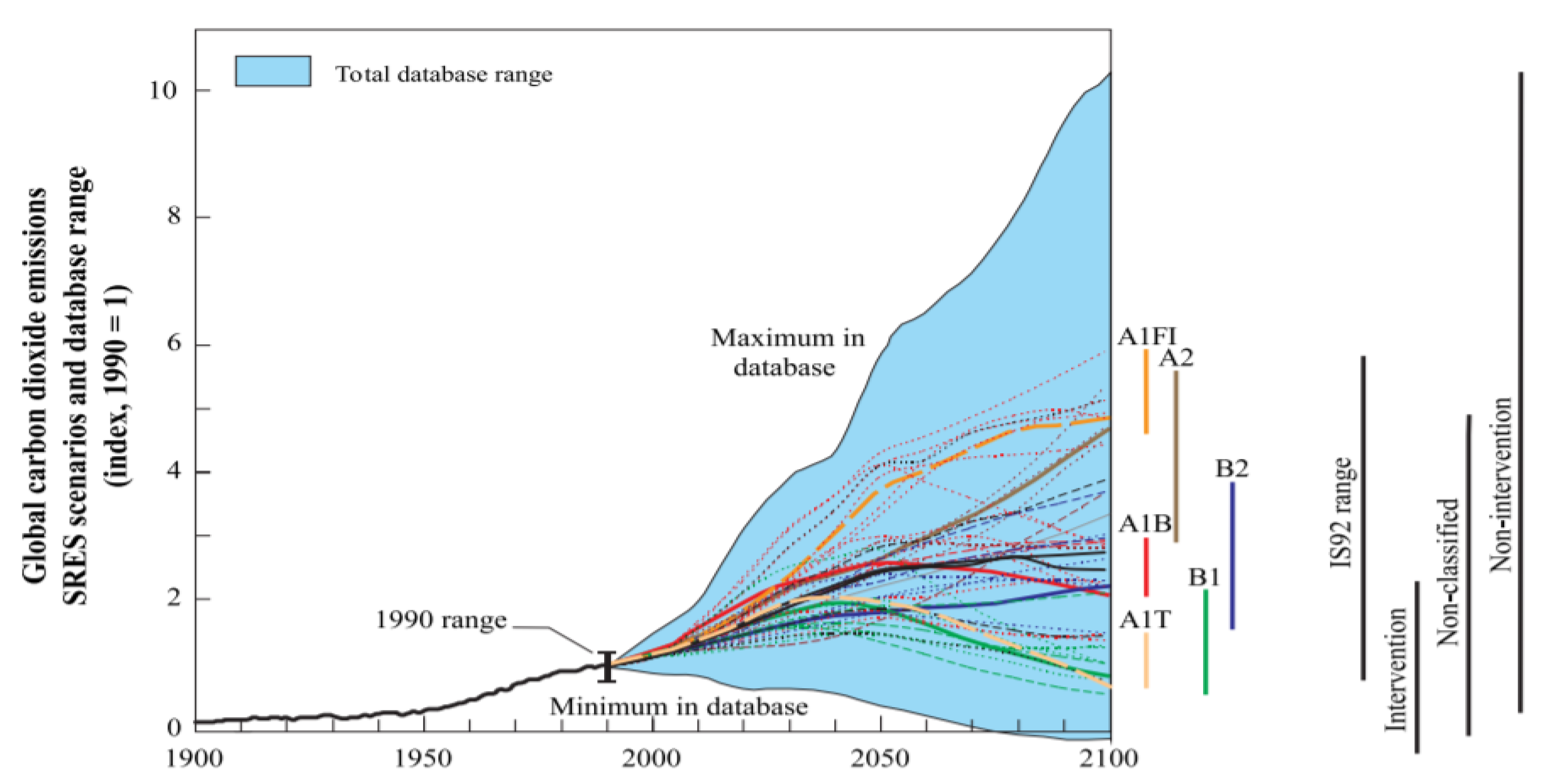


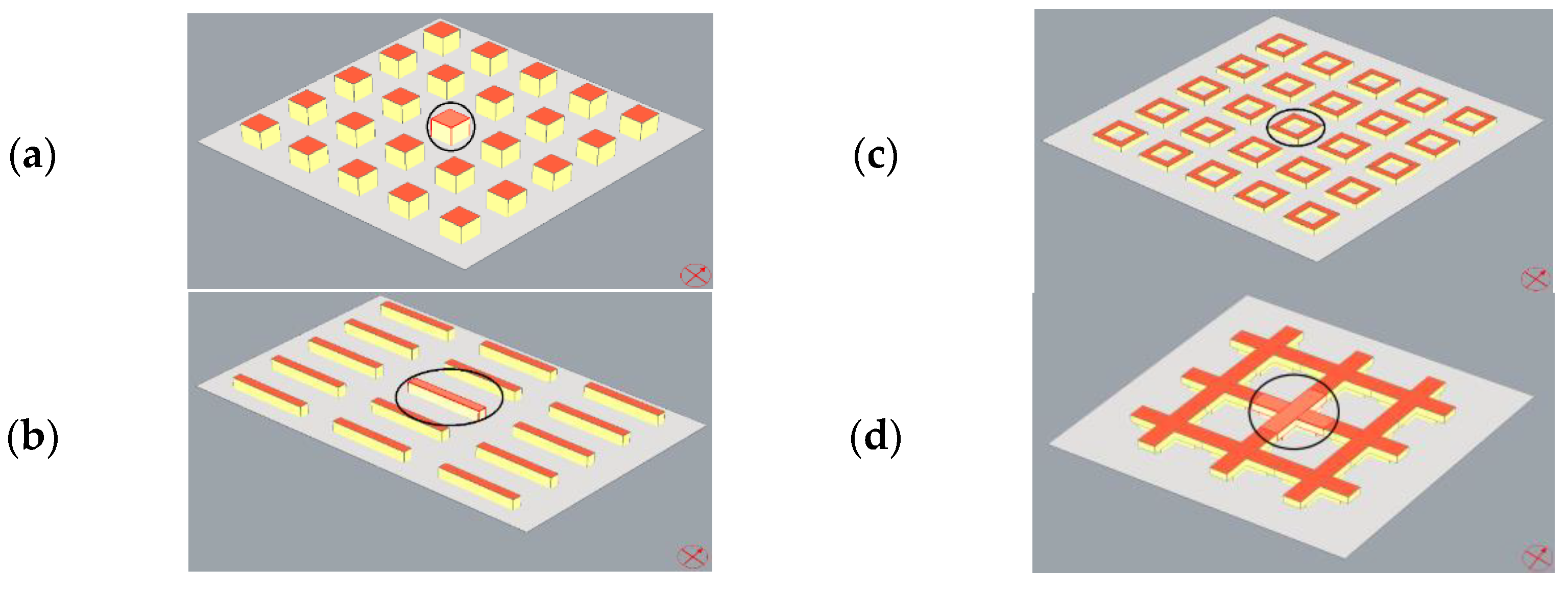
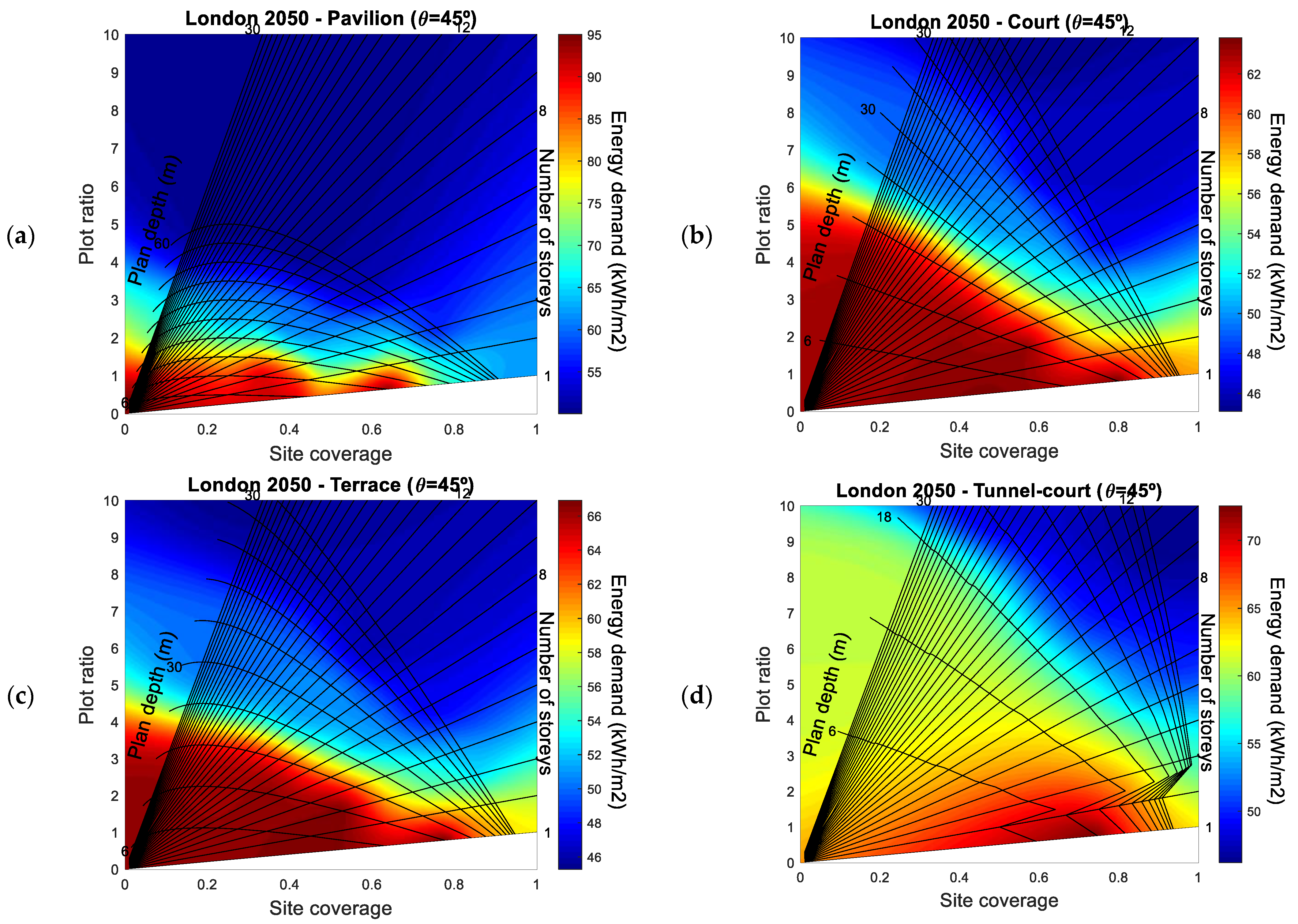


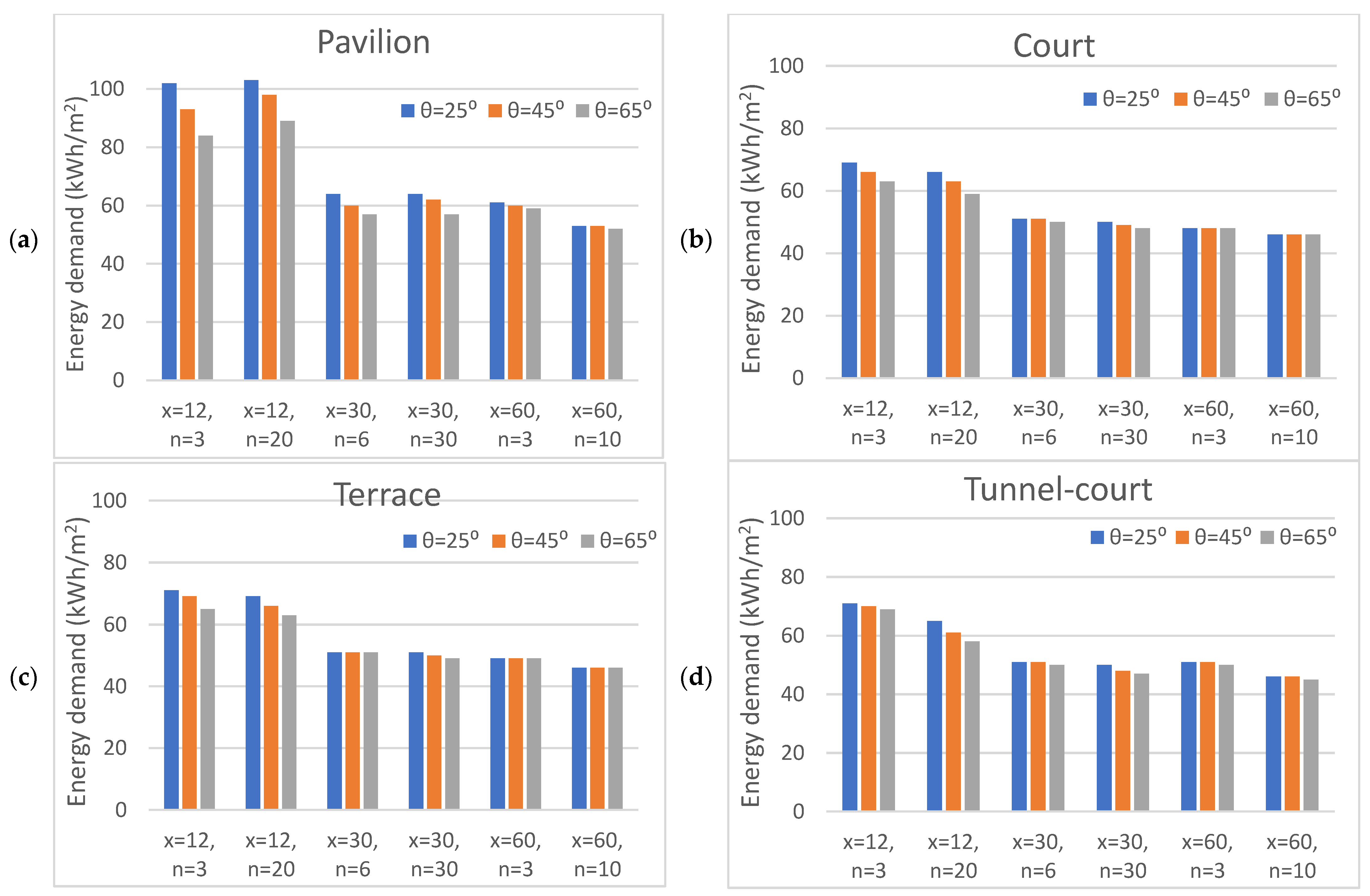
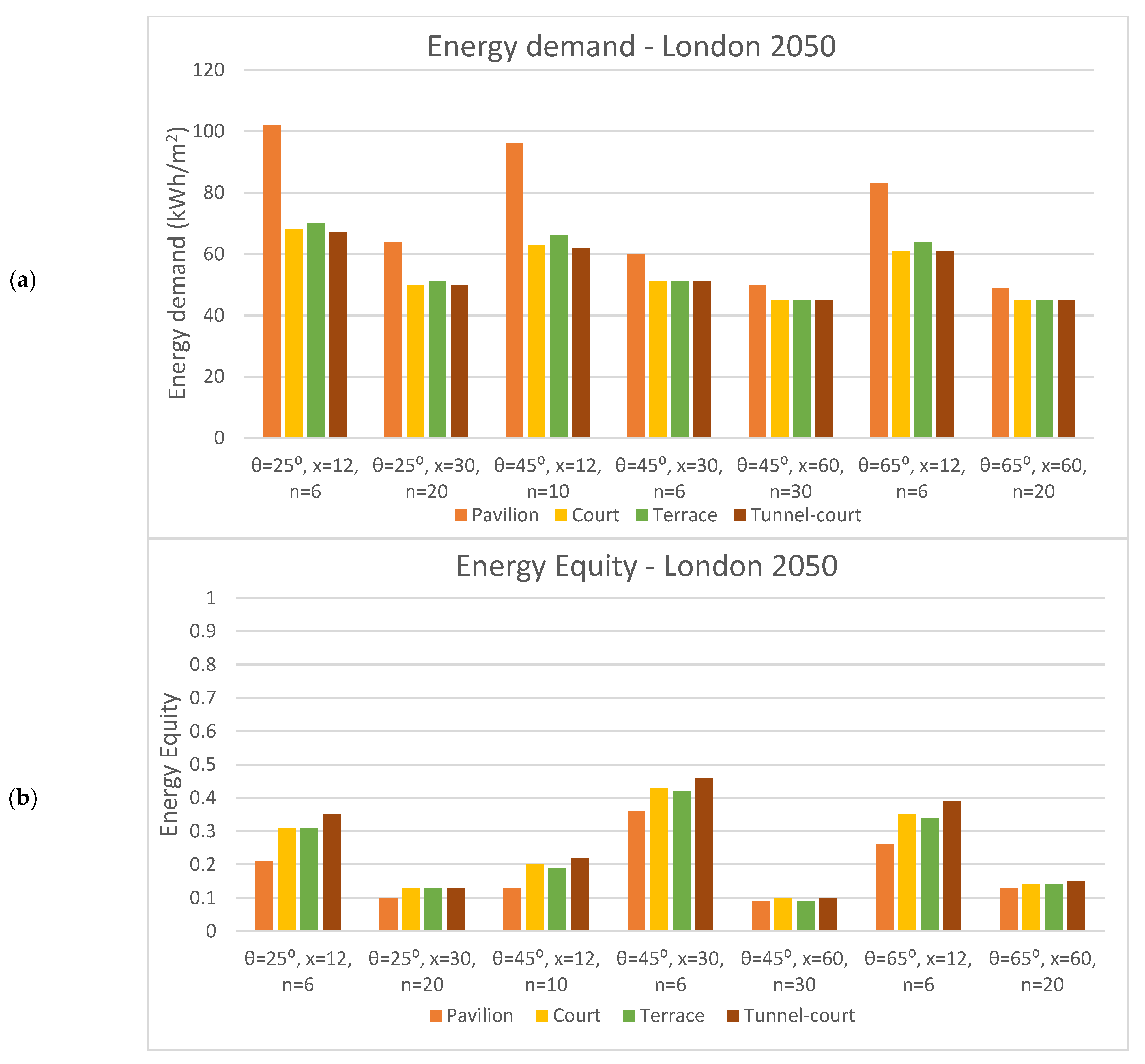
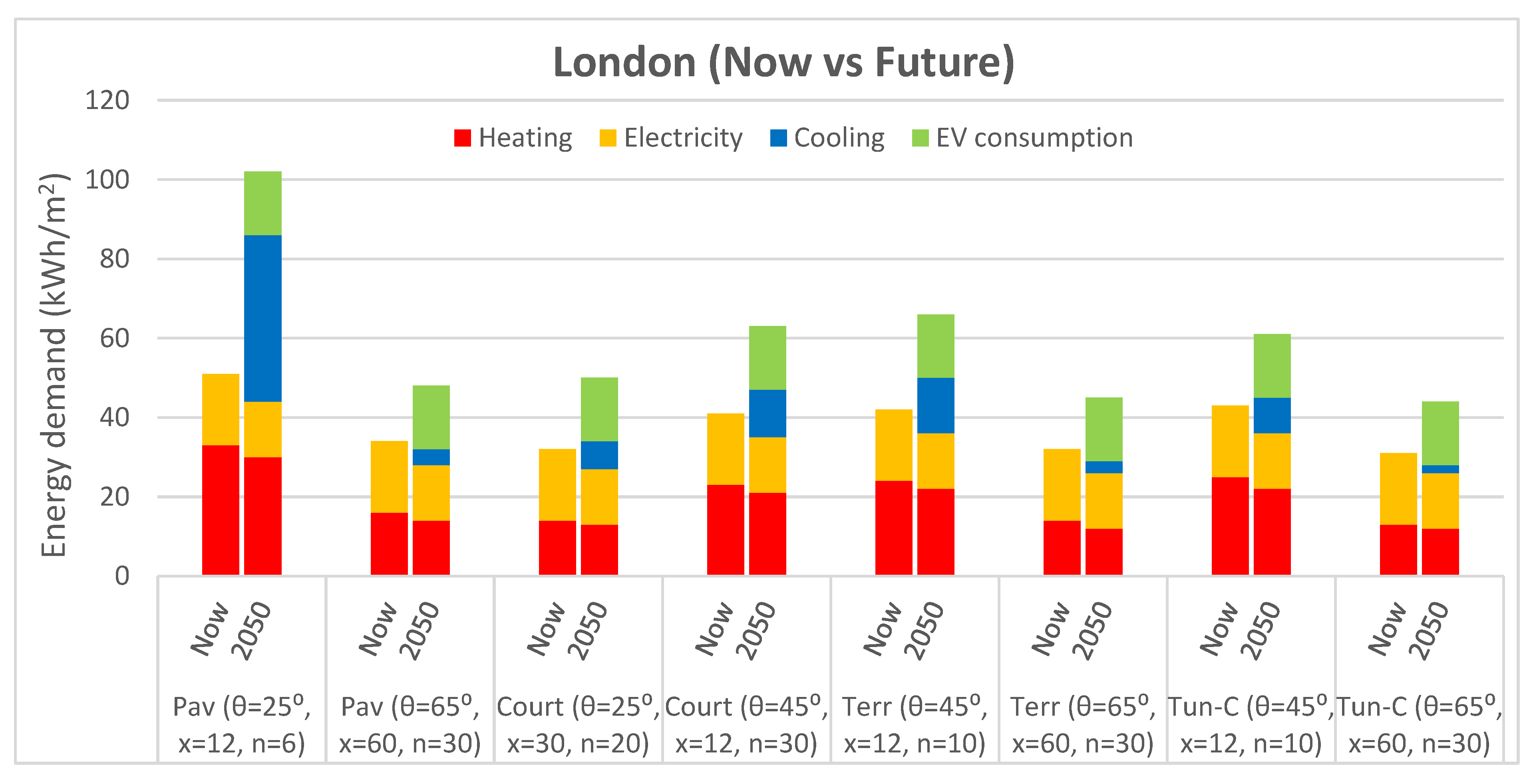
Publisher’s Note: MDPI stays neutral with regard to jurisdictional claims in published maps and institutional affiliations. |
© 2022 by the authors. Licensee MDPI, Basel, Switzerland. This article is an open access article distributed under the terms and conditions of the Creative Commons Attribution (CC BY) license (https://creativecommons.org/licenses/by/4.0/).
Share and Cite
Ahmadian, E.; Bingham, C.; Elnokaly, A.; Sodagar, B.; Verhaert, I. Impact of Climate Change and Technological Innovation on the Energy Performance and Built form of Future Cities. Energies 2022, 15, 8592. https://doi.org/10.3390/en15228592
Ahmadian E, Bingham C, Elnokaly A, Sodagar B, Verhaert I. Impact of Climate Change and Technological Innovation on the Energy Performance and Built form of Future Cities. Energies. 2022; 15(22):8592. https://doi.org/10.3390/en15228592
Chicago/Turabian StyleAhmadian, Ehsan, Chris Bingham, Amira Elnokaly, Behzad Sodagar, and Ivan Verhaert. 2022. "Impact of Climate Change and Technological Innovation on the Energy Performance and Built form of Future Cities" Energies 15, no. 22: 8592. https://doi.org/10.3390/en15228592
APA StyleAhmadian, E., Bingham, C., Elnokaly, A., Sodagar, B., & Verhaert, I. (2022). Impact of Climate Change and Technological Innovation on the Energy Performance and Built form of Future Cities. Energies, 15(22), 8592. https://doi.org/10.3390/en15228592







